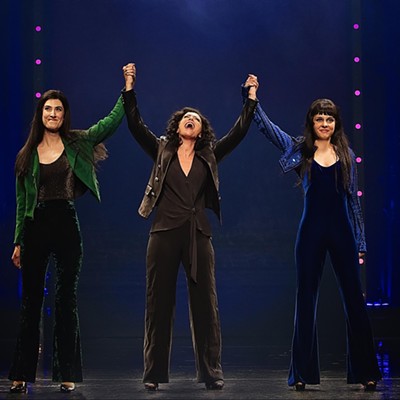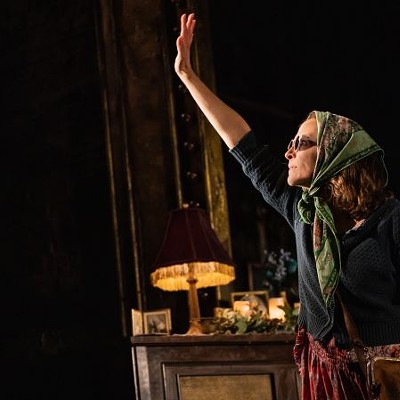It's weird. Despite being one of the most influential writers of all time, and arguably the most important penman of weird tales ever, H. P. Lovecraft remains somewhat of an underground thing. Sure, you'll see Cthulhu bumper stickers, tabletop games, T-shirts and the like, but there's never been a big-screen adaptation of one of his stories. Even Guillermo del Toro can't get At the Mountains of Madness made, and if he can't get Hollywood to shell out the big bucks, then it's likely that no one can.
So, when Dan Lockwood's Lovecraft Anthology Volume I showed up on my doorstep I asked myself, "Does the world really need another Lovecraft comic book?" After all, the Mythos is already being represented in several current ongoing series, homages to it show up in Witch Doctor and League of Extraordinary Gentlemen, and there's just really not anything new to tackle.
No, the world doesn't need it, but that's not to say that it isn't worth picking up. In fact, I'd go so far as to call the anthology the best Lovecraft primer I've ever read.
The collection contains what could be argued are Lovecraft's greatest hits. Call of Cthulhu, Dagon, Shadow of Innsmouth, Colour Out of Space, all the classics with no real surprises in the bunch. What I would've given to see someone tackle the Picture in the House! Still, as I said, if we're treating the collection as a starting place for novices, it makes sense to stick with the stories that have enduring fan bases.
I'm particularly fond of Rob Davis's adaptation of The Dunwich Horror illustrated by I.N.J. Culbard. Dunwhich always seemed a somewhat schlocky tale, mostly dealing with an attempt to open the gate to the Elder Gods through a kind of half-breed demon masquerading as a man named Wilbur Whateley. Like all the stories in the book, the bulk of the text comes straight from the original source with little change, just enough to fit the narrative. It's Culbard's art, though, that really brought the story to life to me for the first time.
It drips with the decrepit, mold-ridden backwoods of New England, and when the full force of the unearthly child of Yog-Sothoth finally makes his awesome, terrible debut, it grabs you in an ecstasy of unbearable shapes and purples that Lovecraft's own prose could never accomplish.
Also on the list of stories I wasn't really a fan of until this collection is the classic The Rats in the Walls. In prose it always seemed like one of Lovecraft's sadder Poe rip-offs, but when David Hartman lends his art to it, suddenly the madness comes full front. Hartman unlocks the horrors beneath Exham Priory with blood-curdling precision.
Lastly, there's Dagon, my favorite story even if the ending is crap and it's basically the first draft of Call of Cthulhu. Lockwood himself did the script, and Alice Duke's drawings belong in a museum for their amazing, Michael Whelan-esque fantasy brilliance. If there was ever a Bat Out of Hell album based on the Mythos, then I hope Duke gets tapped to do the cover.
So another Lovecraft anthology hits the comic shelves, and no, it's not the first. However, putting image to the outlandish vision of Lovecraft ahs always been hard. Under the editorship of Dan Lockwood, it's never been easier to see that which should not be seen.
Lockwood was kind enough to talk with us via e-mail about the collection. Click on over to page 2 for the interview.
Art Attack: Lovecraft has never really broken out into the mainstream the way, say, Poe did. No major motion pictures or things like that. Why do you think that is?
Dan Lockwood: Lovecraft was clearly influenced by Poe, and their combined works are the foundation on which much of modern horror rests, so it does seem odd that Lovecraft's tales never got the mainstream exposure they deserve. But his influence is everywhere in genre fiction, running through horror, science-fiction, fantasy and all manner of comics.
I've heard many variations of "Oh, I always meant to read some Lovecraft, but I never got around to it" since I started working on the Lovecraft Anthology. I think some people are put off his work because of the flowery language, while others can't stomach the appalling racism that creeps into a few of his stories. Lovecraft certainly had his flaws, but he also left a body of work that is original, weird and chilling, and which still draws new fans all these years later.
He's great at building atmosphere little by little, and then BAM he's destroyed your perception of reality by filling the universe with uncaring, impossible monstrosities. It's a real shame that Guillermo del Toro's attempt to film At the Mountains of Madness stalled, because I think that would finally have given Lovecraft his big Hollywood break. If our anthology gets people interested in the original tales, that will be some consolation.
AA: What is the hardest thing about condensing the stories down into comic form?
DL: Lovecraft's prose is very detailed and descriptive. When the scripts started coming in from the adapters, I realized how much of that detail can be compressed into just a few panels while still being effective. So you're cutting down a fair amount of background information in favor of presenting a story that works as a comic. This has the added effect of tightening up some of the slow pacing of the original stories -- there's still plenty of atmosphere, but there's a sense of urgency when necessary. Hopefully in all the right places.
AA: One of the things that seems the hardest about visually portraying the Mythos is how exactly do you represent things like acute angles that act obtuse or Shub-Niggurath? What advice do you have for people trying to attempt to draw them?
DL: In Call of Cthulhu, the artist D'Israeli found himself confronted with drawing those uncanny, deadly angles. His solution for how to convey that idea visually was to appropriate M.C. Escher's style -- I just thought it was ingenious when I first saw it. I think the key is to let Lovecraft's vague and improbable descriptions spark your imagination. I can't pretend to be any kind of artist, but I don't think any two people are ever going to draw these monsters or buildings the same, even with the same source material to guide them. So I guess you just try to draw the most loathsome but baffling thing you can imagine.
AA: You hit all the most famous stories in volume one. Aren't you worried that it'll go downhill from here?
DL: When we started Volume 1, I wasn't sure whether the book would develop into a series. If this was going to be a one-off, I wanted to make sure that we included as many of Lovecraft's "classic" tales -- collectively known as the Cthulhu Mythos -- as possible. As it turned out, the book did well enough that we very quickly started on Volume 2. The stories we've adapted for the second book might not be as well known as those in the first, but they are still amazing pieces of writing and I hope people will stick with the series to experience the rest of his outlandish, creepy body of work.
AA: I notice that for the most part you take the adaptations very, very literally, with little deviation from the original Lovecraft text. Is there anything wrong with looser transitions? After all, there aren't many Lovecraft stories that couldn't use a female lead.
DL: Yes, very early on we decided that these would be as faithful as possible to the originals. Of course, some changes are inevitable -- that's just the nature of adaptation. It's a bit of a balancing act, but I think we've retained the essence and spirit of these stories, even if some of the detail has been trimmed out. But that was just our approach. I don't think there's necessarily anything wrong with taking a looser approach to the material, but it wasn't the direction I wanted to go with the book.
AA: Is Lovecraft's work locked in time, do you think? Is it something that can only exist in the early 20th century, or is there room in the modern world for it?
DL: Well, some of Lovecraft's attitudes were very much of their time. And his florid style of writing seems to have gone out of fashion now, which might highlight the age of the stories. But the best of Lovecraft's tales are timeless. That sounds a little grand, perhaps. But I think readers will keep discovering his work for as long as people keep reading fantastic fiction of any type. His stories and his influence are here to stay. The mainstream will catch on eventually.






